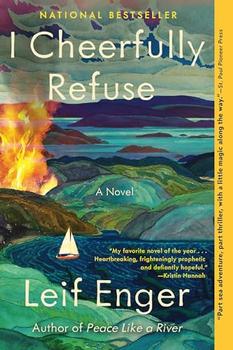Summary | Excerpt | Reading Guide | Reviews | Beyond the Book | Read-Alikes | Genres & Themes | Author Bio

This article relates to I Cheerfully Refuse
 "The setting is a character in itself" is a moth-eaten critical insight about any book (or film, or TV show), but I Cheerfully Refuse stops just short of literally making Lake Superior a character. As the protagonist Rainy sails across the largest of the Great Lakes, he describes it as "a three-hundred-mile fetch of malevolent spirit," praises it for saving him and accuses it of betraying him, and compares it to "her sister the North Atlantic and her cousins the hurricanes." Even if he never set sail, Rainy's life in his hometown of Icebridge is shaped by its proximity to the lake, just as it would be if he lived in Lightner, Winton, Brighton, or any of the other villages he visits over the course of the novel.
"The setting is a character in itself" is a moth-eaten critical insight about any book (or film, or TV show), but I Cheerfully Refuse stops just short of literally making Lake Superior a character. As the protagonist Rainy sails across the largest of the Great Lakes, he describes it as "a three-hundred-mile fetch of malevolent spirit," praises it for saving him and accuses it of betraying him, and compares it to "her sister the North Atlantic and her cousins the hurricanes." Even if he never set sail, Rainy's life in his hometown of Icebridge is shaped by its proximity to the lake, just as it would be if he lived in Lightner, Winton, Brighton, or any of the other villages he visits over the course of the novel.
Rainy often uses the word "sea" interchangeably with "lake" to describe Superior, and for good reason. If you were to stand on the shore and look out at the water, it would more closely resemble an ocean than, say, the hottest kayaking spot in your nearest state park. It is huge — by surface area at 31,700 sq mi/82,100 sq km it's the largest freshwater lake in the world — and as the countless dead sailors rising to the surface throughout the novel can attest, it can be extremely dangerous. (The Edmund Fitzgerald, the doomed ship immortalized by Gordon Lightfoot, may be Lake Superior's most famous casualty.)
Named gichi-gami, or "great sea," by the Ojibwe (written as "Gitche Gumee" in the opening lines of Longfellow's epic poem "The Song of Hiawatha"), Lake Superior received its current name from French explorers in the 16th century, who called it le lac supérieur, or "the upper lake," as it was located above Lake Huron. The name was, of course, apt in other ways: the largest of the Great Lakes, it also contains 10% of the world's surface freshwater.
Most of the communities Rainy mentions on the shores of Lake Superior — his hometown of Icebridge, gentle Jolie, oppressive Blinker, and besieged Brighton — do not exist in real life (which makes sense, seeing as I Cheerfully Refuse is set in the future after America functionally collapses). The most prominent exceptions are Duluth, a city in Minnesota where Rainy and Lark first met, and Thunder Bay, a city in Ontario where Rainy makes a crucial pit stop. Other locations are Michipicoten Island, where Rainy and co. run into serious trouble, and the longed-for Slate Islands, which are in fact a (real) archipelago but not, as far as we know, a place where dead authors or wives congregate as suggested in the novel.
Lake Superior as seen from the International Space Station, courtesy of NASA
Filed under Nature and the Environment
![]() This "beyond the book article" relates to I Cheerfully Refuse. It originally ran in April 2024 and has been updated for the
April 2025 paperback edition.
Go to magazine.
This "beyond the book article" relates to I Cheerfully Refuse. It originally ran in April 2024 and has been updated for the
April 2025 paperback edition.
Go to magazine.
Your guide toexceptional books
BookBrowse seeks out and recommends the best in contemporary fiction and nonfiction—books that not only engage and entertain but also deepen our understanding of ourselves and the world around us.